Life isn’t black and white. With the launch of the brand new Levo SL, Specialized have blurred the line between analogue and electric mountain bikes. For us, the new release was the perfect excuse to hit the trails and compare three of the American brand’s most popular trail bikes: the Stumpjumper, the Levo and the Levo SL. Which is the right bike for you?
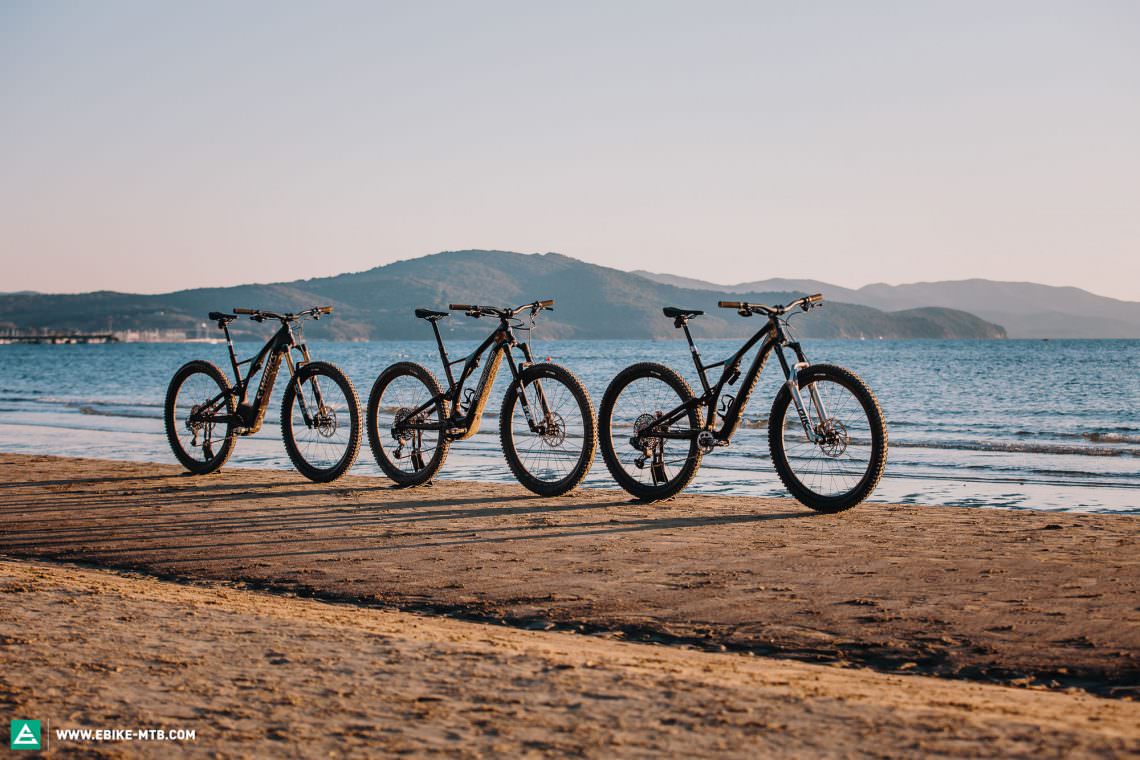
Specialized’s non-motorized Stumpjumper and its electric counterpart, the Levo, are undoubtedly two of the most popular and perhaps best-known bikes in their categories. The iconic Stumpjumper was launched as a hardtail back in 1981 and has been instrumental in shaping innovative developments and new technologies ever since. With the launch of the Levo in 2015, the American brand caused a stir in the eMTB world and its new eMTB quickly became one of the hottest options on the market. The high level of integration, connectivity and last but not least, its nimble handling and appealing looks made it a bestseller. After some initial teething problems, from 2018 the Levo dominated every major group test in our sister magazine E-MOUNTAINBIKE. But instead of resting on their laurels, Specialized’s eMTB department went back to the drawing board and came up with yet another innovation. Staying true to their motto “Innovate or die”, they have announced the brand new Specialized Levo SL.

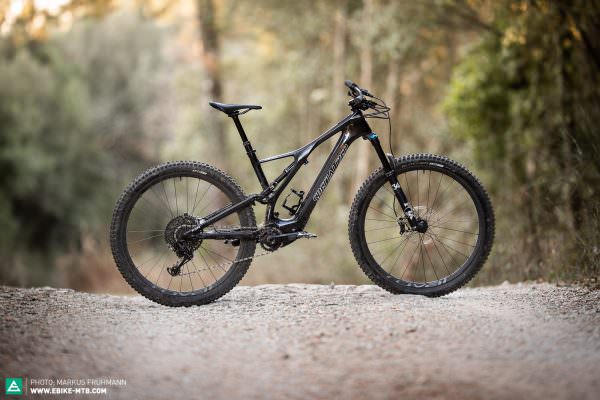

What exactly is the Specialized Levo SL? Is it defining a whole new category of (e)MTBs?
Together with the Lapierre eZesty and the NOX Helium, the Specialized Levo SL falls into a new category of super-light eMTB bikes fitted with a smaller motor that is lighter but provide less support than conventional eMTBs. Instead of relying on the compact FAZUA drive like NOX and Lapierre, the engineers at Specialized decided to use their own drive system, just like they did previously with the Levo. In this case, it’s a 35 Nm-strong Levo SL 1.1 motor, which was developed in close collaboration with MAHLE. With its compact motor and 320 Wh battery, visually the Levo SL fits right in between the Stumpjumper and the Levo. Only when you get closer will you notice that this is actually an ebike. The Levo SL shares many of the Stumpy’s typical design features, like the asymmetrical frame with its trademark sidearm and suspension linkage. Due to the lower power output and significantly lower system weight compared to conventional eMTB, models like the Levo SL are extremely interesting for eMTBers and mountain bikers alike. At least, that was the resounding conclusion of the big trail bike group test in our sister magazine ENDURO, which saw the Levo SL coming out on top of its motorless competitors and taking home our coveted Best Buy tip.
Watt the fact
We admit that comparing these three very different bikes directly might be pushing it a little. After all, the S-Works Levo and the S-Works Stumpjumper SRAM AXS 29 come with a dream-like spec, while at € 8.699 the Levo SL is a lower-end model with a more modest spec. That’s because we received the Levo SL well before its official presentation and Specialized could only provide us with an Expert model at the time. Therefore, it would be pointless to compare the performance of single components like the fork or the groupset. It’s more about the holistic concept and helping you figure out which concept works better for you.
Gewicht
As far as weight goes, the numbers speak for themselves. It goes without saying that the Stumpjumper is by far the lightest bike in this comparison. But how light is too light and how heavy is too heavy? Is the 17.7 kg Levo SL light enough to take on a light trail bike? Or does it fall into the category of conventional eMTB bikes, which start at around 20 kg? You’ll find all the answers in our riding impressions.

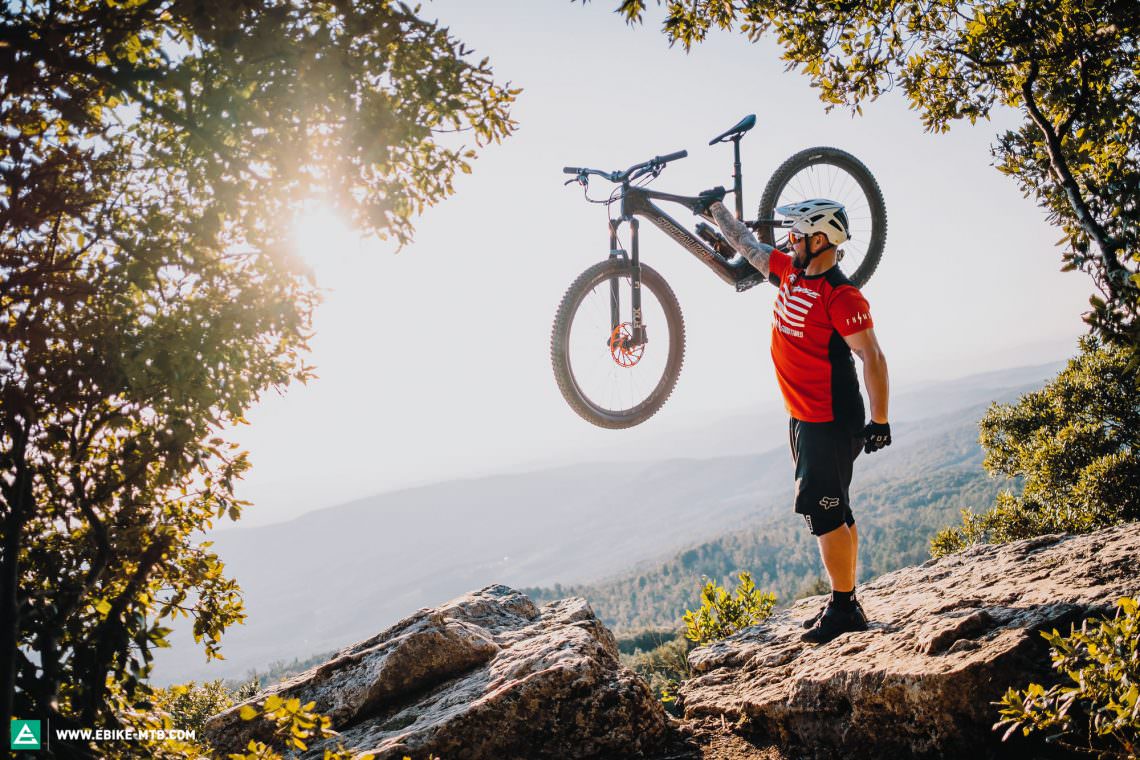
Motorpower
As far as motor power goes, the Levo keeps up with most conventional eMTBs. The Specialized 2.1 motor churns out a whopping 90 Nm of torque and offers up to 410% assistance. The Levo SL features Specialized’s own SL 1.1 motor. This is the same motor found on the Turbo Creo, just with a different software tune. The motor delivers 35 Nm of torque and doubles your power input at peak performance.

Battery capacity
A big motor needs a big battery. The Levo has a battery capacity of 700 Wh, which is more than twice that of the Levo SL’s 320 Wh. Yet this doesn’t actually tell us which bike has the bigger range. Even without the additional 160 Wh range extender battery, the Levo SL can take you surprisingly far. More on this later.

This is how the bikes performed on the trail
Perusing the specs of the three bikes, you might be misled into assuming that the Levo SL is just a compromise between the Stumpjumper and the Levo. But here at E-MOUNTAINBIKE we don’t like judging a book by its cover, so we don’t evaluate a bike’s performance by analysing numbers and geometry tables. What we’re really interested in is how the bike behaves on the trail. Suffice to say we were surprised by the results!
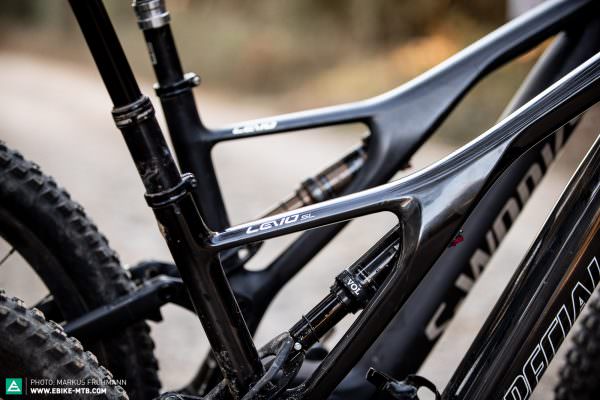

Full power uphill
Nowhere was the performance of the three bikes more different than riding uphill. In the maximum support level, the Levo quadruples your pedalling input and literally catapults you up the steepest of ramps at the 25 km/h assistance threshold. Tricky technical climbs, which you wouldn’t even dream of tackling aboard the Stumpjumper, are quickly dispatched with the Levo. All you have to do is accelerate briefly before a ramp, keep your weight centered to maintain traction on the rear wheel and use the power of the motor to roll over ledges and obstacles. The powerful motor also has just enough hysteresis to compensate for those moments you have to stop pedalling to prevent your pedals from slamming into roots and rocks. When approaching tight switchbacks on a climb, we recommend you keep a finger on the brake to prevent the motor from pushing you off line. Speed, cornering stability and the wind blowing through your hair, even on the way up the mountain, make the Levo a true fun machine.
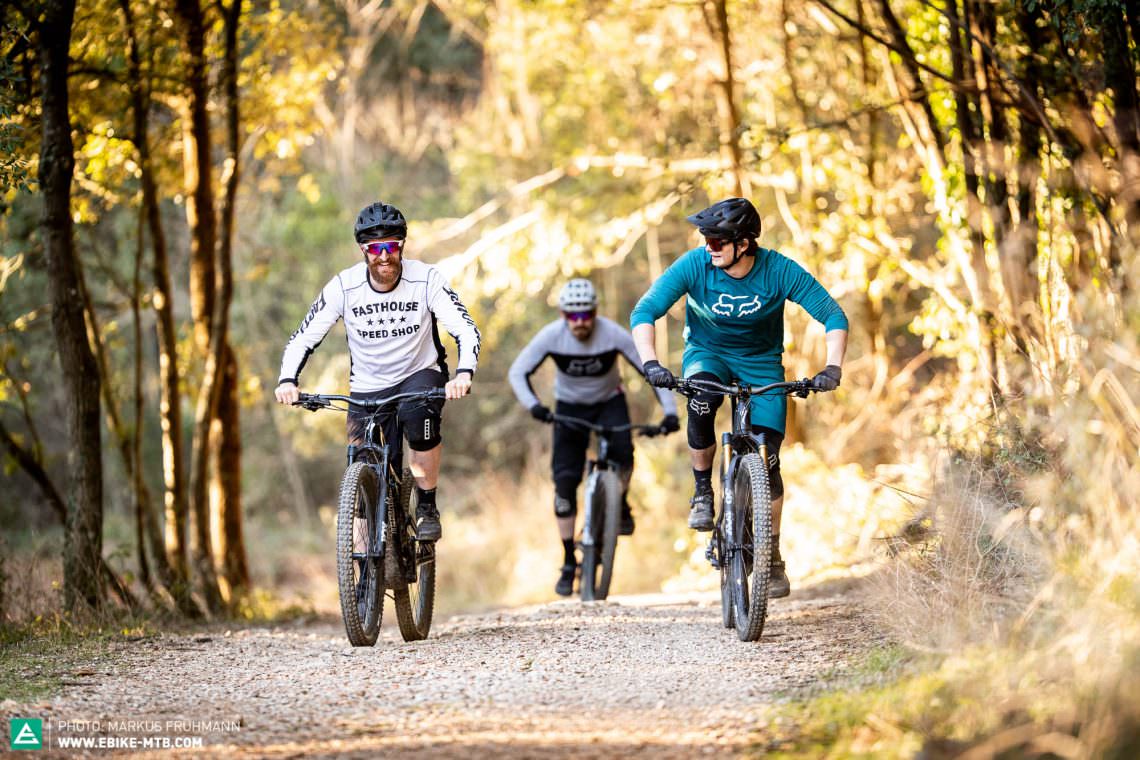
Unfortunately, neither the Stumpjumper nor the Levo SL will give you the same sensation an eMTB gives you on the way up. With both bikes, you’ll have to take it easier on long climbs and fire roads and shift into an easier gear. Unlike the Levo, here the motto is “You’ll get there when you get there.” On flatter sections, you’ll only realise that the natural power of the Levo SL’s 35 Nm motor is there once you turn the motor off (and realise it’s missing).
Fit riders on a Stumpjumper will be able to keep up with someone riding the Levo SL in the low support mode. However, the medium support level already makes you feel like your winter workout is paying off and you’re at peak fitness and riding fast! While the Levo and Levo SL benefit from the even chain tension typical of motorised bikes, the rear-end of the Stumpjumper tends to bob quite a lot pedalling uphill. Inevitably, on steep ramps, the Levo SL eventually pulls past the Stumpjumper. However, despite having a motor, the Levo SL will still raise your heartrate. While you can let it winch you up steep climbs slowly, this drains the battery fast. You’ll have to put in an effort yourself if you want to move more quickly or go on longer rides.
Just like the Levo, the Levo SL will happily tackle all sort of technical sections, provided you pick the right gear! Of course, it will get you there with a lot less momentum but in return provides more predictable and agile handling. Here, the Stumpjumper clearly lags behind. However, the one big advantage of the Stumpjumper is that the only noise you hear comes from the tires.Both the Levo and the Levo SL develop a loud buzzing noise from the motor, which varies in intensity depending on how hard they’re working.
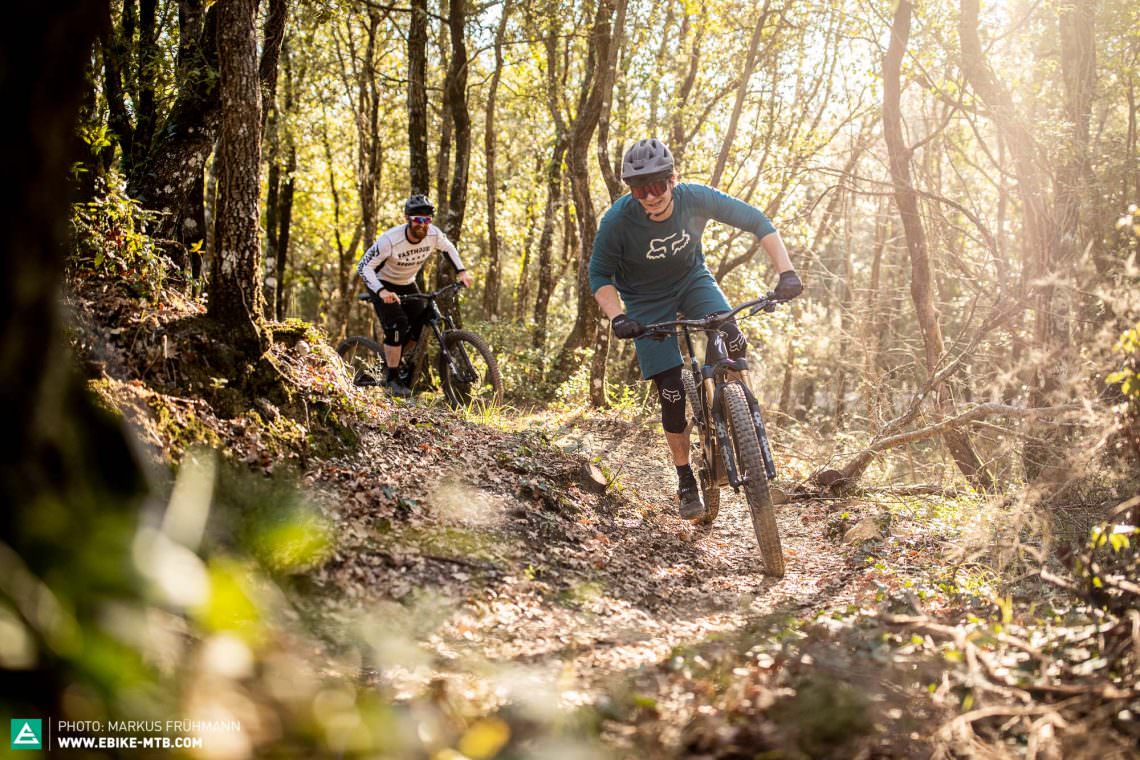
Planning your ride: how far will you get?
When it comes to planning your tour, both the Levo SL and Stumpjumper are very similar. While the Levo SL and Levo’s motor both ride without resistance if you have a flat battery, with the Levo SL it’s actually feasible to pedal longer distances without the support of the motor. On the other hand, with the Levo you’ll have to work really hard to get to the trailhead without any support. If you run out of battery, the Levo feels like you’re climbing with the brakes on. In general, with its big 700 Wh, the battery of the Levo has more than enough range for long after-work sessions.However, if you’re planning to embark on long backcountry adventure, make sure you plan a charging stop, unless you want to ride in Eco mode all day long! By contrast, with both the Stumpjumper and the Levo SL it’s your fitness level that sets the pace, not the bike! Your legs and your motivation will dictate whether you climb 500, 1,000 or 2,000 vertical meters – no matter whether you’re riding with little or no support. One advantage of the Levo SL? It takes the edge off scary ramps and nasty climbs, which means you can include tougher climbs on your route.
Without the motor-support the Levo SL pedals just like a Stumpjumper
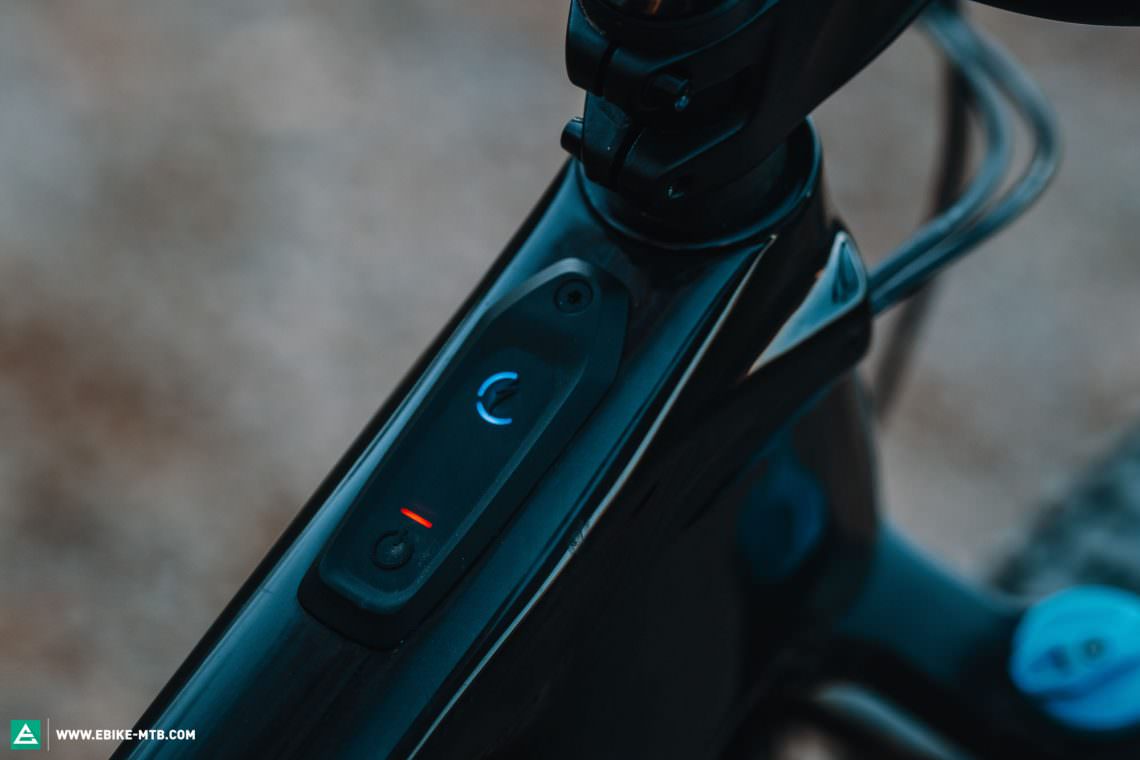
As you probably know, it’s impossible to formulate a general rule about the range of an eMTB. There are quite simply too many factors that are impossible to control and determine. This also implies that most lab tests give a very distorted picture of reality, simply because they don’t take into account the many variables you come across in real world conditions. Specialized’s Mission Control app is compatible with both the Levo and the Levo SL and allows for range-based navigation. On top of this, the app smartly adapts the support of the motor to the riding scenario and allows you to get to your destination without the risk of running out of power. As if that wasn’t enough, the app also allows you to configure the Levo SL’s range extender. During our test runs in Tuscany, the Levo SL regularly managed over 1,000 vertical meters over a distance of 25 km on just one battery charge – and that’s without the additional battery and without riding too frugally. Another test ride who weighs just under 90 kg, managed similar figures, but rode way faster and got to his destination a lot more quickly. The chief editor of our sister magazine E-MOUNTAINBIKE has already done some test runs with the S-Works version of the Levo SL. Weighing in at 72 kg, Robin squeezed in 1,015 vertical meters over 33 km in 2 hours and 20 minutes. He used an average support of 82%, which used up three quarters of the battery.

And when you shred your way back down into the valley, it’s a lot more fun without a motor, isn’t it?
As soon as you turn downhill, the power of the motor plays a secondary role. However, the weight of the motor and battery, as well as the geometry of the bike – which is often adapted to fit around the voluminous drive unit – can have a significant impact on the handling of the bike, both in good and bad ways.
Chainstays
A strong motor takes up lots of room around the bottom bracket. This is why the pivot point of the main bearing on the Levo cannot be positioned as close to the bottom bracket as on the Stumpjumper or the Levo SL, which has a significantly smaller motor. As a result, the chainstays of the Levo are 18 mm longer.

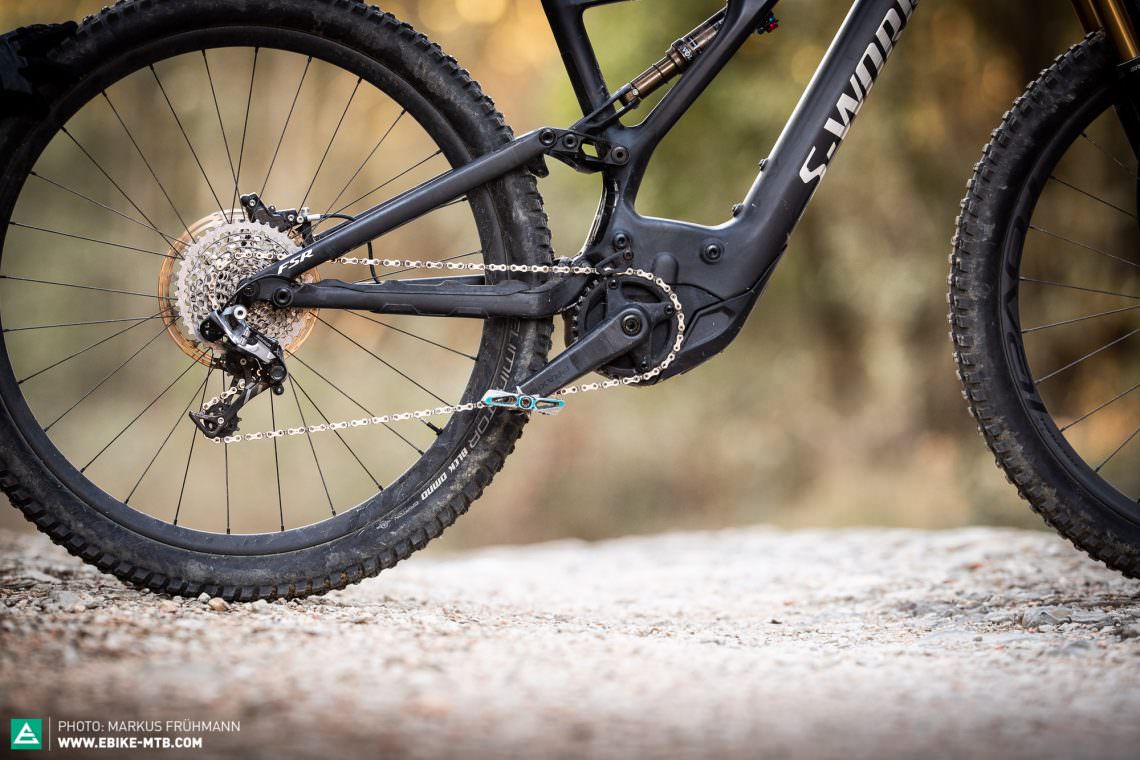
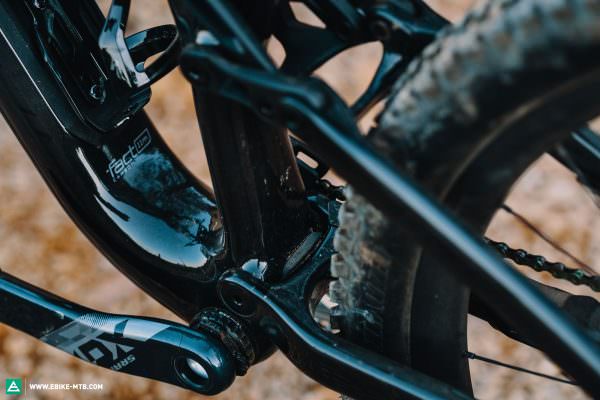

In addition, the Levo is quite a bit heavier and doesn’t feel as nimble on the trail as a result. While it’s easy to throw both the Levo SL and the Stumpjumper from one corner into another, the Levo requires more physical strength and a more active riding style to implement quick direction changes and spontaneous manoeuvers. On the Levo SL and the Stumpjumper, the rider stays further back than on the Levo, which has a more centred and front-heavy riding position. As a result, the front ends of both the Stumpy and the Levo SL feel a lot lighter and thus more agile, allowing for more creative line choices and making it easier to pull manuals. The centred riding position and heavier weight of the Levo generate tons of traction and provide great cornering grip through long, open turns. While it’s true that you’ll need more strength to slam the Levo into a corner, once you’re set up, it will carve through turns like a freight train on speed, even on loose terrain.
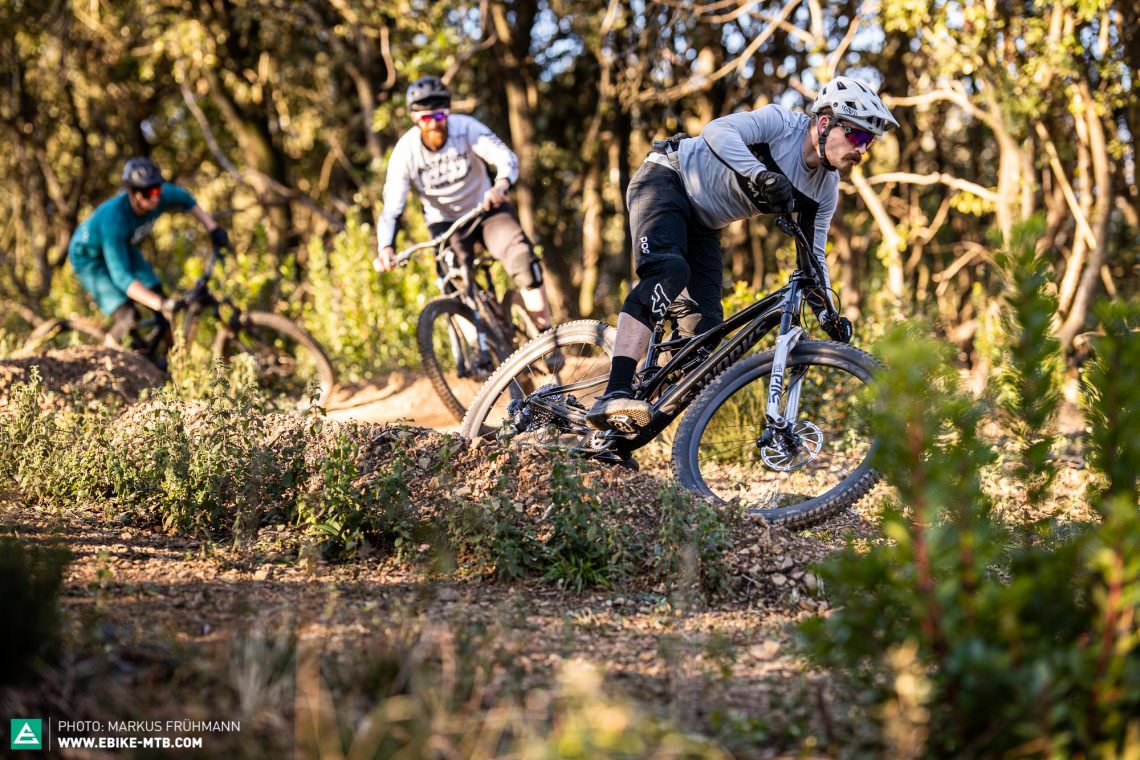
Bikes like the Levo SL will change mountain biking, just like disc brakes and suspension forks did a few years ago.
When popping off ledges, the classic Levo requires more physical effort and a more active riding style than the other two bikes. In a direct comparison, the Levo SL gets up in the air very eagerly. The Stumpjumper turns it up another notch and baits you into a rowdy riding style, begging you to pop off ledges whenever you can. It’s exactly these kind of scenarios that bring out the biggest differences between the Levo SL and the 4 kg lighter Stumpjumper, despite both bikes sharing very similar handling. While the weight gap between the Levo SL and the Levo is smaller, the Levo feels more cumbersome on the trail. In particular, when riding steep sections or when braking, the extra mass of the Levo pulls you forward and requires a strong hand to be controlled. However, the Levo also feels more stable, which becomes very evident through messy rock gardens. The Levo tells you: choose your line, stick to it and smash through! In contrast, the more compact Stumpjumper gets knocked off the line more easily, requiring you to pick your way through blocked terrain or gap obstacles rather than just blasting through them. The Levo SL strikes a middle ground, combining the best of two worlds: it’s nimble enough to allow for spontaneous line changes and yet stable enough to charge obstacles and steam over them.
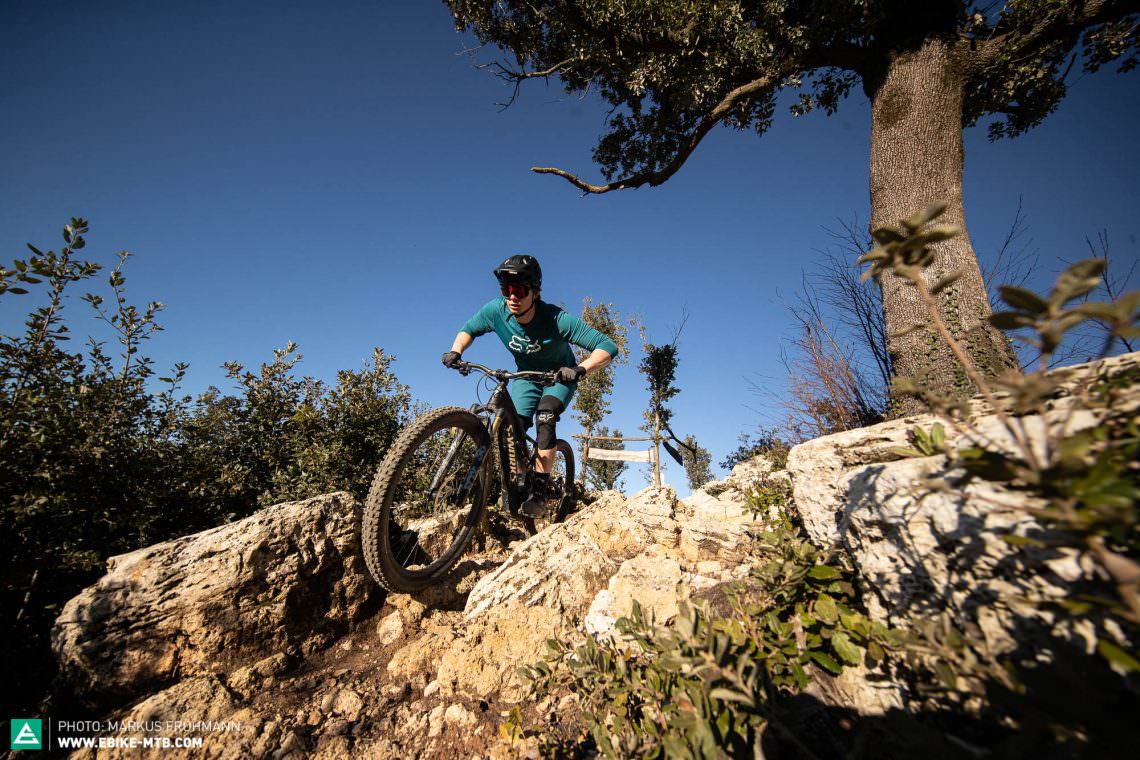
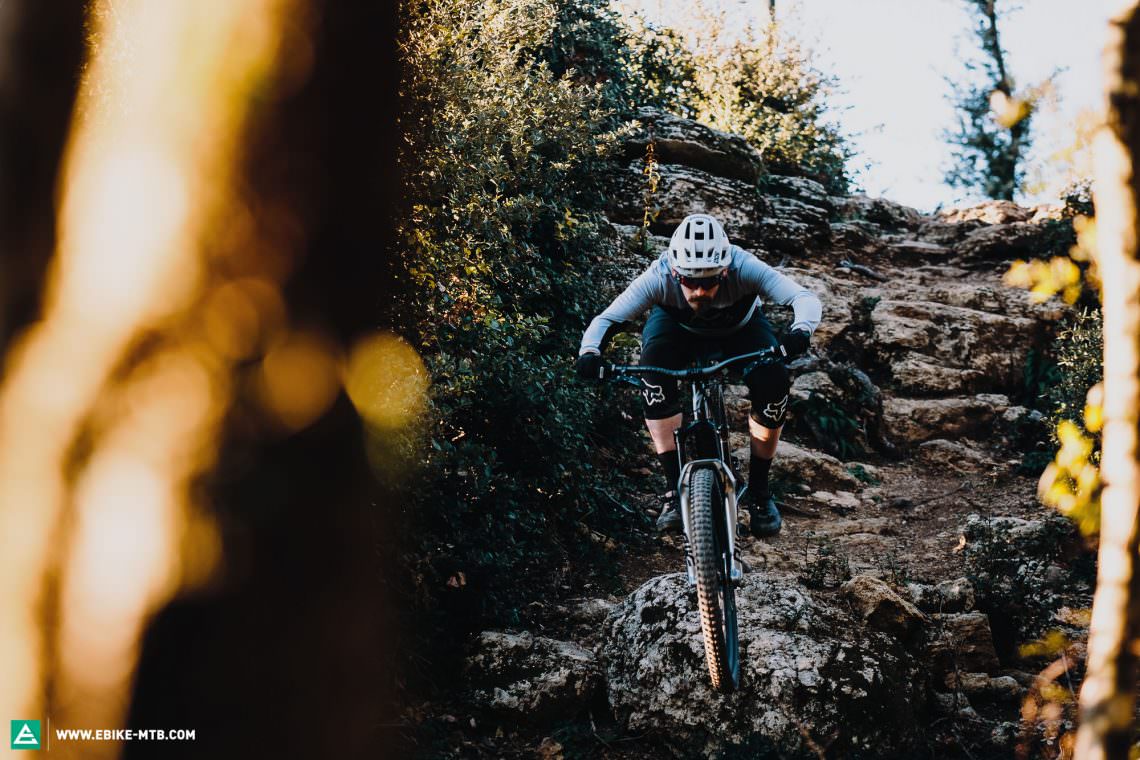
Are motorless trail bikes in danger of extinction?
To understand which bike is right for you, you need to ask yourself where and how you want to ride it. For everyday practicality off the trail, the Levo is the best choice. You can use it to commute without breaking a sweat and then take on some serious trails on your way back home. On the weekend, you can use it to tow your kids, or a crate of your favourite beer, around town in a trailer (though bear in mind that Specialized hasn’t approved the use of trailers yet). The Levo is also a great option if you want to wave goodbye to the lift or uplift at the bike park but still want to squeeze in as many laps as possible. Apart from that, the Levo is a lot of fun on the way up and doesn’t mind being thrown sideways into corners on the uphills. On fast paced, after work laps, you can tear up endless trails in the highest support level without running out of juice. However, mixed electric/analogue rides aren’t fun for anyone, because the powerful Levo is capable of tearing apart even the most solid and purist eMTB groups. On the way down, one thing becomes clear: while the handling of the Levo is still phenomenal compared to many other eMTBs, it’s fundamentally different from conventional trail bikes.
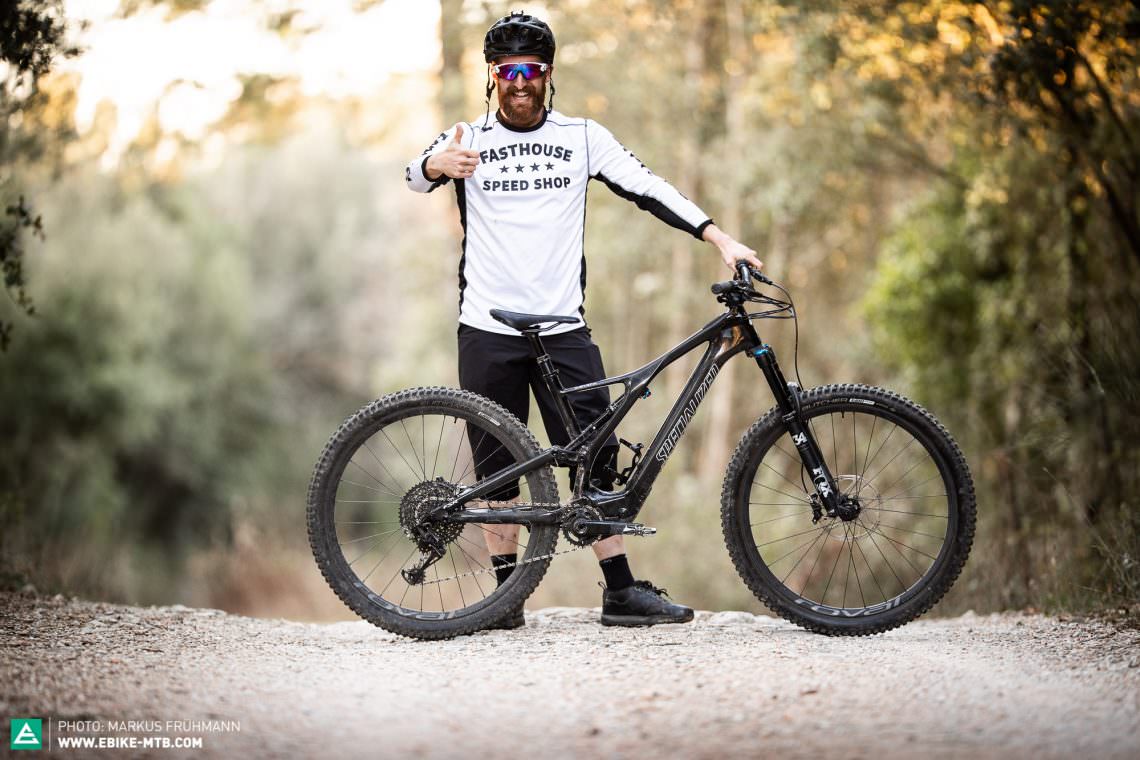
At the other end of the spectrum, there’s one question we’re both excited and afraid to ask: who should choose the Stumpjumper? Frankly, there are only a few things that speak just for it. If you regularly embark on long rides with more than vertical 1,400 metres and lots of hike-a-bike, the Stumpjumper is your best pick. However in most other scenarios, the new Specialized Levo SL does almost everything better than the Stumpjumper, which is now almost two years old. The Levo SL combines the best of both worlds inheriting agile and direct handling from the Stumpjumper and increased stability in rough terrain from the low center of gravity and additional weight of the motor. Downhill it strikes a superb balance between stability and agility and feels more balanced than the Stumpjumper, arguably making it more fun to ride. Moreover, it can fully exploit the advantages of its motor power on the way to the trailhead, making it the ideal choice for trail riders.
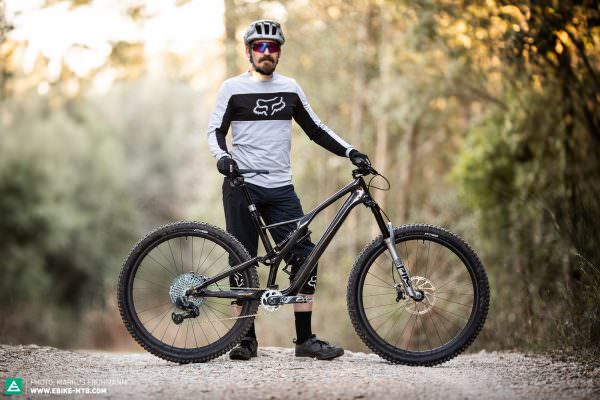
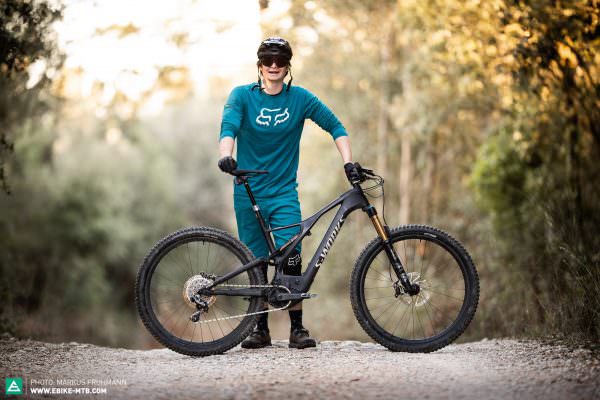
Conclusion
The Specialized Levo SL gets the best of both worlds, combining the agile and playful handling of the Stumpjumper on the way down with the perks of the Levo on the way up. If you’re after maximum climbing speed and want to cram in as many descents as possible, you’ll still have to resort to the more powerful Levo. However, the days of the Stumpjumper are numbered, simply because the new Specialized Levo SL is the better Stumpjumper. We’ll have to wait another year to see how these latest developments will affect the legendary Stumpjumper and all other bikes in its category. The bottom line is that we might just have to get used to a new world order and accept that innovations such as SRAM’s AXS technology and motors are becoming an integral part of our bikes. No one can stop the electrification of high-end mountain bikes.
More info at: specialized.com
Here you can find more about the Specialized Levo SL and eMTB light:
- Exclusive first ride review: Specialized S-Works Levo SL 2020 (Click for review)
- How the Levo SL is changing the face of mountain biking! (Click for ENDURO article)
- Specialized Levo SL Expert Carbon on test (Click for the ENDURO group test)
- Exclusive Review: Lapierre eZesty AM LTD Ultimate (Click for review)
- NOX HeLIUM 5.9 ALL-MOUNTAIN Pro on test (Click for review)
Did you enjoy this article? If so, we would be stoked if you decide to support us with a monthly contribution. By becoming a supporter of E-MOUNTAINBIKE, you will help secure a sustainable future for high-quality cycling journalism. Click here to learn more.
Words: Photos: Christoph Bayer, Markus Frühmann









